Studying the Effect of Cr and Si on the High-Temperature Oxidation-Resistance Mechanism of Hot Stamping Steel
Abstract
:1. Introduction
2. Materials and Methods
3. Results and Discussion
3.1. Effect of Cr and Si on Oxidation Kinetics
3.2. Effect of Cr and Si on Oxide Surface Morphology
3.3. Effect of Cr and Si on Oxide Structure
3.4. Effect of Cr and Si on the Oxidation Mechanism of Hot Stamping Steel
4. Conclusions
- According to the thermogravimetric curves, new coating-free Cr-Si hot stamping steel has a higher oxidation activation energy, indicating that Cr and Si elements improve the oxidation resistance of hot stamping steel in a wide temperature range. However, the thermogravimetric fitting results show that the oxidation mechanisms of Cr-Si hot stamping steel are different at 800–1000 °C and 1000–1200 °C. The oxidation resistance of Cr-Si hot stamping steel at 800–1000 °C is two times better than 22MnB5 but worse than 22MnB5 at 1000–1200 °C.
- The Fe-Cr-Si-O layer formed between the Fe-O layer and the substrate altered the iron oxide structure of conventional hot stamping steel. It is worth noticing that the oxidization temperature significantly affected the structure of the Fe-Cr-Si-O layer in coating-free Cr-Si hot stamping steel. At 800–1000 °C, coating-free Cr-Si hot stamping steel generated a Cr-Si-rich solid Fe-Cr-Si-O layer, while the Fe-Cr-Si-O layer melted and was left with holes or gaps when oxidized over 1100 °C.
- Adding Cr and Si elements imparts excellent short-term (≤7.5 min) oxidation resistance to hot stamping steel. Due to the selective oxidation of Si and Cr elements and the rapid formation of the Fe-Cr-Si-O layer, the diffusion of Fe from the substrate to the Fe oxide layer is inhibited, thereby improving the oxidation resistance of hot stamping steel.
- The long-term (≥15 min) oxidation resistance of coating-free Cr-Si hot stamping steels is inferior to that of 22MnB5 when oxidized at ≥1100 °C. The higher the Si content, the worse the oxidation resistance. The Fe-Cr-Si-O layer melts at the interface between the oxide layer and the substrate, and liquid Fe2SiO4 penetrates the Fe oxide layer, which promotes the diffusion of Fe. Correspondingly, the oxidation efficiency of 22MnB5 is hindered by gaps between the oxide layer and substrate due to local blistering.
Author Contributions
Funding
Data Availability Statement
Conflicts of Interest
References
- Jin, X.; Gong, Y.; Han, X.; Du, H.; Ding, W.; Zhu, B.; Zhang, Y.; Feng, Y.; Ma, M.; Liang, B.; et al. A Review of Current State and Prospect of the Manufacturing and Application of Advanced Hot Stamping Automobile Steels. Acta Metall. Sin. 2020, 56, 411–428. [Google Scholar]
- Nanda, T.; Singh, V.; Singh, V.; Chakraborty, A.; Sharma, S. Third Generation of Advanced High-Strength Steels: Processing Routes and Properties. Proc. Inst. Mech. Eng. Part. L J. Mater. Des. Appl. 2019, 233, 209–238. [Google Scholar] [CrossRef]
- Li, S.; Luo, H. Medium-Mn Steels for Hot Forming Application in the Automotive Industry. Int. J. Miner. Metall. Mater. 2021, 28, 741–753. [Google Scholar] [CrossRef]
- Karbasian, H.; Tekkaya, A.E. A Review on Hot Stamping. J. Mater. Process. Technol. 2010, 210, 2103–2118. [Google Scholar] [CrossRef]
- Rana, R.; Singh, S.B. Automotive Steels: Design, Metallurgy, Processing and Applications; Rana, R., Singh, S.B., Eds.; Woodhead publishing: Duxford, UK, 2017; pp. 387–411. [Google Scholar]
- Geslain, E.; Rogeon, P.; Cretteur, L.; Merdji, Y. Effect of heat treatment on weldability of Al-Si coated hot-stamped Usibor® 1500P. Surf. Coat. Technol. 2022, 445, 128750. [Google Scholar] [CrossRef]
- Liu, L.; Fan, C.; Sun, H.; Chen, F.; Guo, J.; Huang, T. Research Progress of Alumina-Forming Austenitic Stainless Steels: A Review. Materials 2022, 15, 3515. [Google Scholar] [CrossRef]
- He, H.; Yu, L.; Liu, C.; Li, H.; Gao, Q.; Liu, Y. Research Progress of a Novel Martensitic Heat-Resistant Steel G115. Acta Metall. Sin. 2021, 58, 311–323. [Google Scholar]
- Wonneberger, R.; Seyring, M.; Freiberg, K.; Carlsson, A.; Rensberg, J.; Abendroth, B.; Stöcker, H.; Rettenmayr, M.; Undisz, A. Oxidation of stainless steel 316L–Oxide grains with pronounced inhomogeneous composition. Corros. Sci. 2019, 149, 178–184. [Google Scholar] [CrossRef]
- Shen, L.; Wang, Y.; Jing, T.; Peng, H.; Wen, Y. Oxidation resistance and mechanical properties of Al2O3-forming and SiO2-forming austenitic stainless steels between 1023 K and 1173. Corros. Sci. 2023, 211, 110914. [Google Scholar] [CrossRef]
- Zhu, R.; Wang, M.; Mi, Z.; Zhang, Q.; Yang, X.Y.; Yang, Y.G.; Wu, Y.X. Effects of nano-ceramic additives on high-temperature mechanical properties and corrosion behavior of 310S austenitic stainless steel. J. Iron Steel Res. Int. 2023, 30, 591–600. [Google Scholar] [CrossRef]
- Mouayd, A.A.; Koltsov, A.; Sutter, E.; Tribollet, B. Effect of silicon content in steel and oxidation temperature on scale growth and morphology. Mater. Chem. Phys. 2014, 143, 996–1004. [Google Scholar] [CrossRef]
- Park, J.Y.; Hwang, N.M.; Seo, B.; Im, H.T.; Par, K.B.; Park, C.S.; Mo, C.B.; Park, H.-K.; Park, K. Study on surface modification of Fe–Si–Cr alloy by selective oxidation heat treatment and its corrosion properties. Steel Res. Int. 2023, 94, 2200236. [Google Scholar] [CrossRef]
- Wang, T.; Ma, S.; Cheng, S.; Chen, H.; Lv, P.; Wang, J.; Xing, J.; Ma, S. Microstructure and High Temperature Oxidation Resistance of Directionally Solidified Fe-18wt.% 5Cr-3wt.% B-Si Alloy. Surf. Technol. 2021, 50, 270–278. [Google Scholar]
- Zeng, W.; Zhou, M.; Yang, M.; Qiu, R.; Tan, X.; Zhou, A.; Luo, X. Influence of Manganese Content on Microstructure, Mechanical Properties and High Temperature Oxidation Resistance of Reduced Activation Ferritic/Martensitic Steels. J. Mater. Eng. Perform. 2023, 1–12. [Google Scholar] [CrossRef]
- Zhang, L.; Yan, W.; Shi, Q.; Li, Y.; Shan, Y.; Yang, K. Silicon Enhances High-Temperature Oxidation Resistance of SIMP Steel at 700 °C. Corros. Sci. 2020, 167, 108519. [Google Scholar] [CrossRef]
- Hao, M.; Sun, B.; Wang, H. High-Temperature Oxidation Behavior of Fe–1Cr–0.2Si Steel. Materials 2020, 13, 509. [Google Scholar] [CrossRef]
- Wang, S.; Wu, Y.; Ni, C.S.; Niu, Y. The Effect of Si Additions on the High Temperature Oxidation of a Ternary Ni-10Cr-4Al Alloy in 1 Atm O-2 at 1100 Degrees C. Corros. Sci. 2009, 51, 511–517. [Google Scholar] [CrossRef]
- Li, Z.; He, Y.; Cao, G.; Lin, F.; Liu, Z. Comparative Study on Oxidation Behavior of Fe-5wt% Cr Alloy in Various Mixed Atmospheres at 900–1000 °C. J. Wuhan Univ. Technol.-Mater. 2018, 33, 1496–1502. [Google Scholar] [CrossRef]
- Suzuki, T.; Ono, Y.; Miyamoto, G.; Furuhara, T. Effects of Si and Cr on Bainite Microstructure of Medium Carbon Steels. ISIJ Int. 2010, 50, 1476–1482. [Google Scholar] [CrossRef]
- Li, S.; Wen, P.; Li, S.; Song, W.; Wang, Y.; Luo, H. A Novel Medium-Mn Steel with Superior Mechanical Properties and Marginal Oxidization after Press Hardening. Acta Mater. 2021, 205, 116567. [Google Scholar] [CrossRef]
- Chai, Z.; Lu, Q.; Tedesco, S.; Shi, M.; Coryell, J.; Reini, L.; Lai, Q.; Wang, J.; Wang, L.; Xu, W. Investigation on Mechanical Properties and Oxidation Behavior of 1.2 and 1.7 GPa Grades Coating-Free Press-Hardened Steels. Metals 2023, 13, 489. [Google Scholar] [CrossRef]
- Suarez, L.; Schneider, J.; Houbaert, Y. Effect of Si on High-Temperature Oxidation of Steel during Hot Rolling. In Defect and Diffusion Forum; Trans Tech Publications Ltd.: Bäch, Switzerland, 2008; Volume 273–276, pp. 655–660. [Google Scholar]
- Yuan, Q.; Xu, G.; Zhou, M.; He, B. The Effect of the Si Content on the Morphology and Amount of Fe2SiO4 in Low Carbon Steels. Metals 2016, 6, 94. [Google Scholar] [CrossRef]
- Yuan, Q.; Xu, G.; Liang, W.; Zhou, M.; Hu, H. Effects of Oxygen Concentration on the Passivation of Si-Containing Steel during High-Temperature Oxidation. Corros. Rev. 2018, 36, 385–393. [Google Scholar] [CrossRef]
- Liu, X.J.; Cao, G.M.; He, Y.Q.; Jia, T.; Liu, Z.Y. Effect of Temperature on Scale Morphology of Fe-1. 5Si Alloy. J. Iron Steel Res. Int. 2013, 20, 73–78. [Google Scholar] [CrossRef]
- Bonnet, G.; Aguilar, G.; Colson, J.C.; Larpin, J.P. The Effect of Rare Earths Deposited on Steel Surfaces, by Different Processes (Sol/Gel, Electrophoresis, OMCVD), on High Temperature Corrosion Behaviour. Corros. Sci. 1993, 35, 893–899. [Google Scholar] [CrossRef]
- Zhang, J.; Dong, H.; Xi, X.; Tang, H.; Li, X.; Rao, J.H.; Xiao, Z. Enhanced mechanical performance of duplex stainless steels via dense core-shell nano-inclusions in-situ formed upon selective laser melting. Scr. Mater. 2023, 237, 115711. [Google Scholar] [CrossRef]
- Yang, Y.L.; Yang, C.H.; Lin, S.N.; Chen, C.H.; Tsai, W.T. Effects of Si and Its Content on the Scale Formation on Hot-Rolled Steel Strips. Mater. Chem. Phys. 2008, 112, 566–571. [Google Scholar] [CrossRef]
- Yuan, Q.; Xu, G.; Zhou, M.; He, B. New Insights into the Effects of Silicon Content on the Oxidation Process in Silicon-Containing Steels. Int. J. Miner. Metall. Mater. 2016, 23, 1048–1055. [Google Scholar] [CrossRef]
- Yuan, Q.; Xu, G.; He, B.; Zhou, M.; Hu, H. A Method to Reduce the Oxide Scale of Silicon-Containing Steels by Adjusting the Heating Route. Trans. Indian Inst. Met. 2018, 71, 677–684. [Google Scholar] [CrossRef]
- Yuan, Q.; Xu, G.; Liang, W.; He, B.; Zhou, M. Effects of Oxygen Content on the Oxidation Process of Si-Containing Steel during Anisothermal Heating. Int. J. Miner. Metall. Mater. 2018, 25, 164–172. [Google Scholar] [CrossRef]
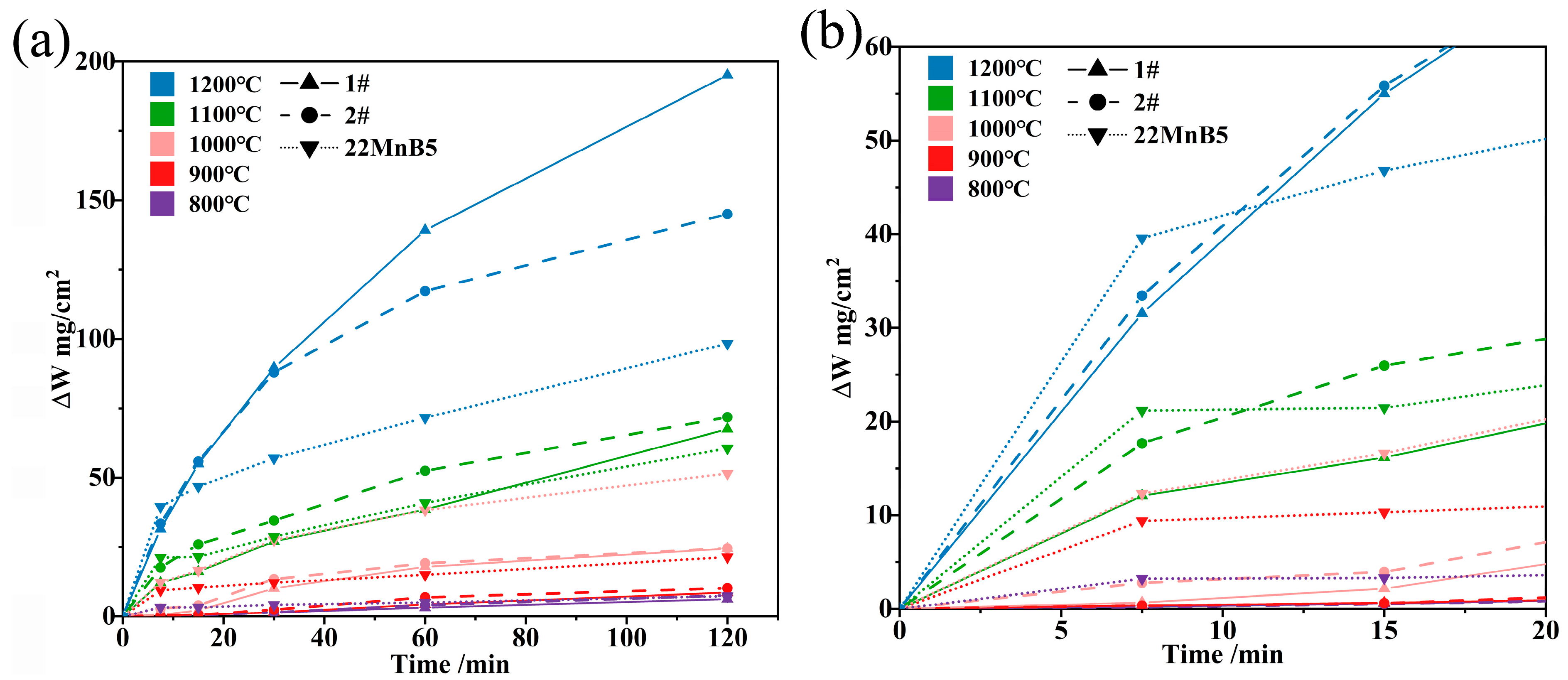
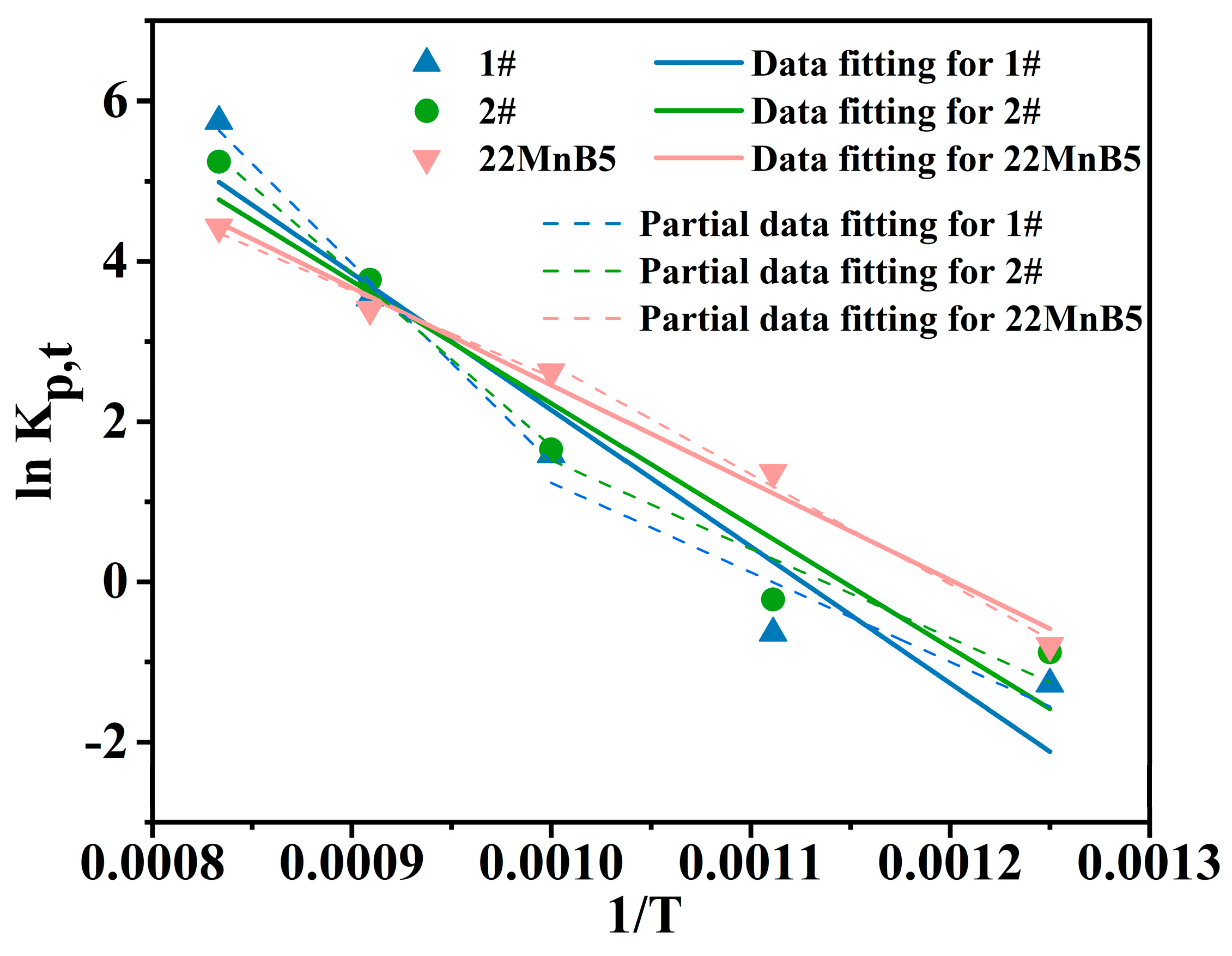


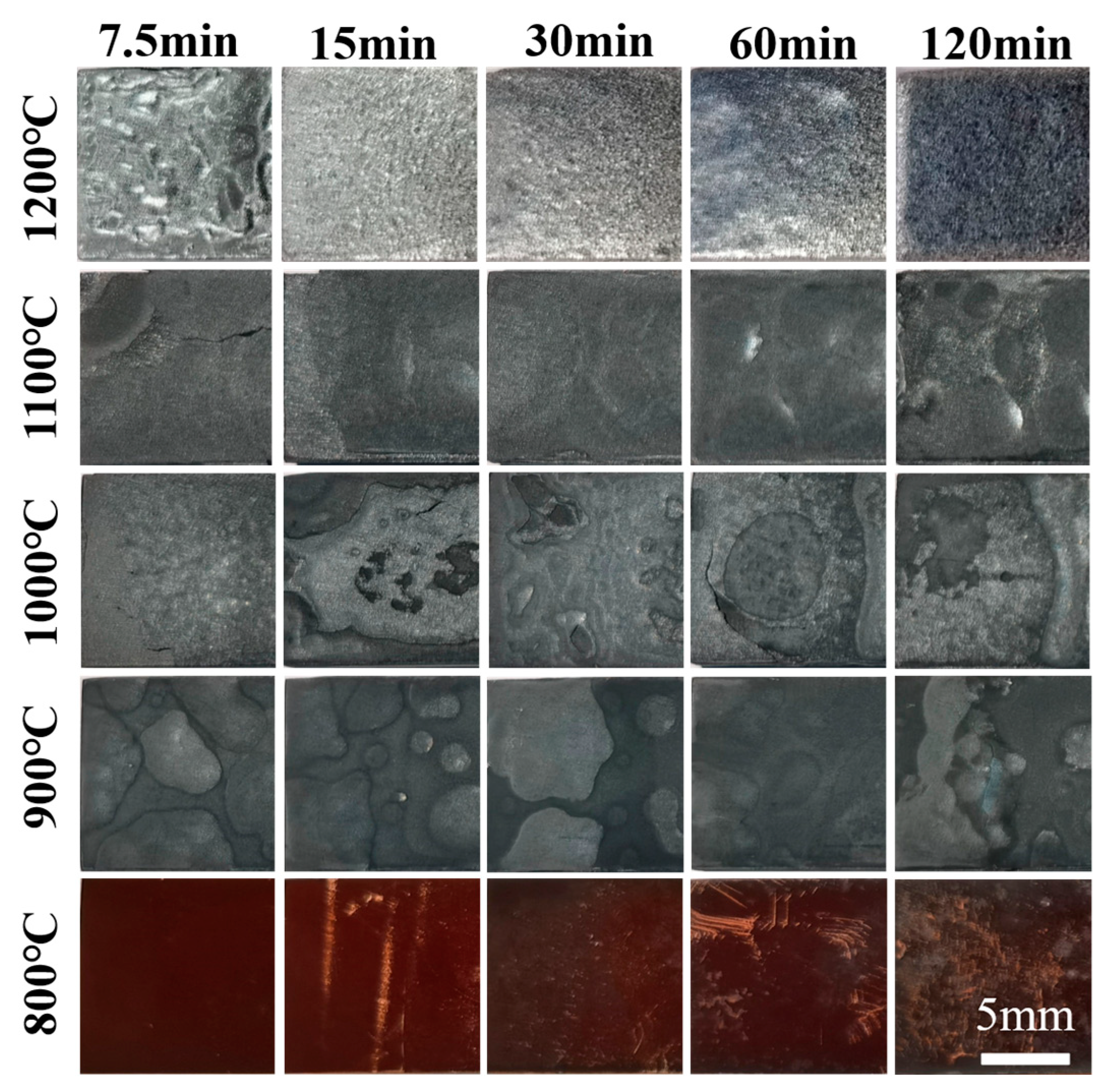


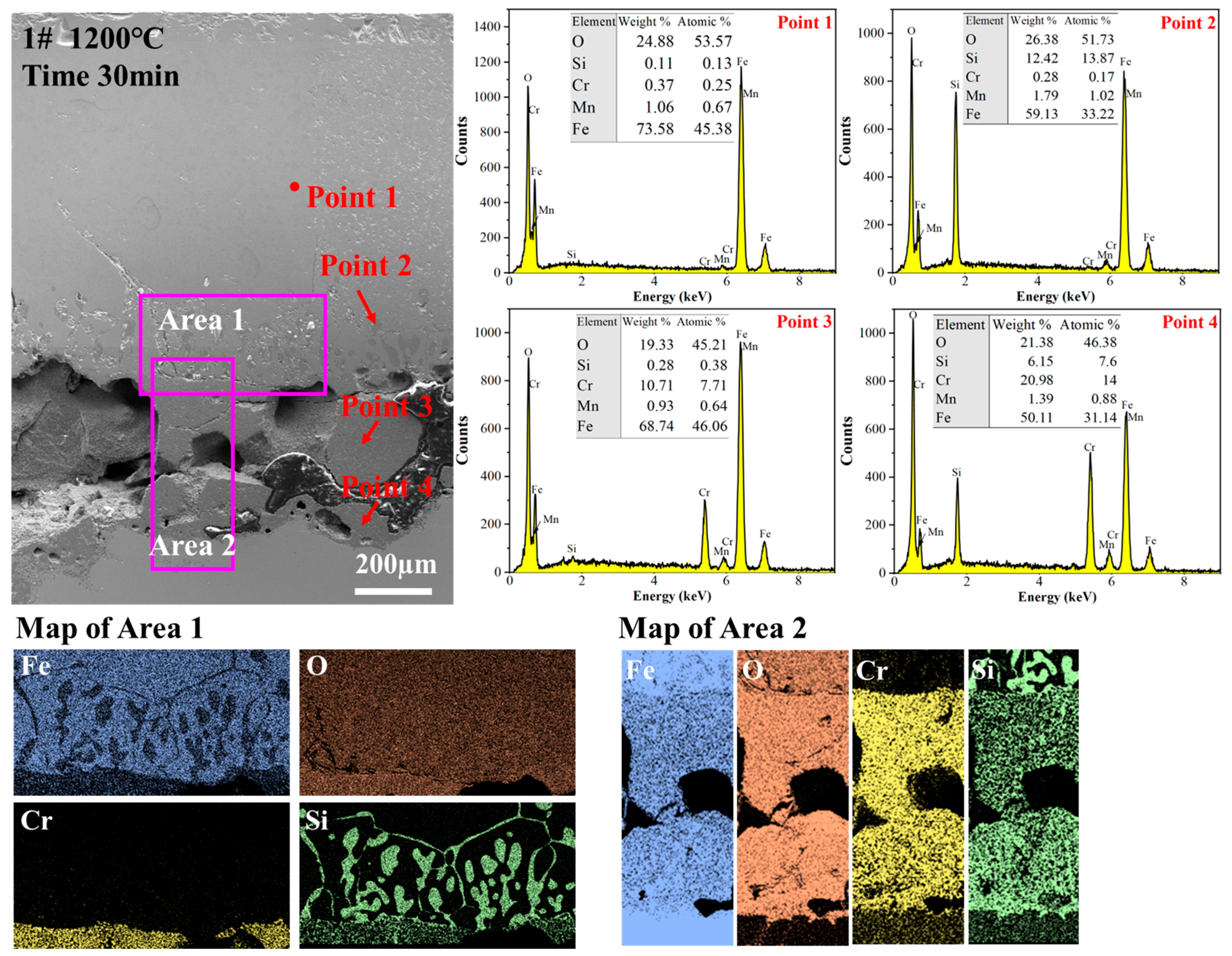
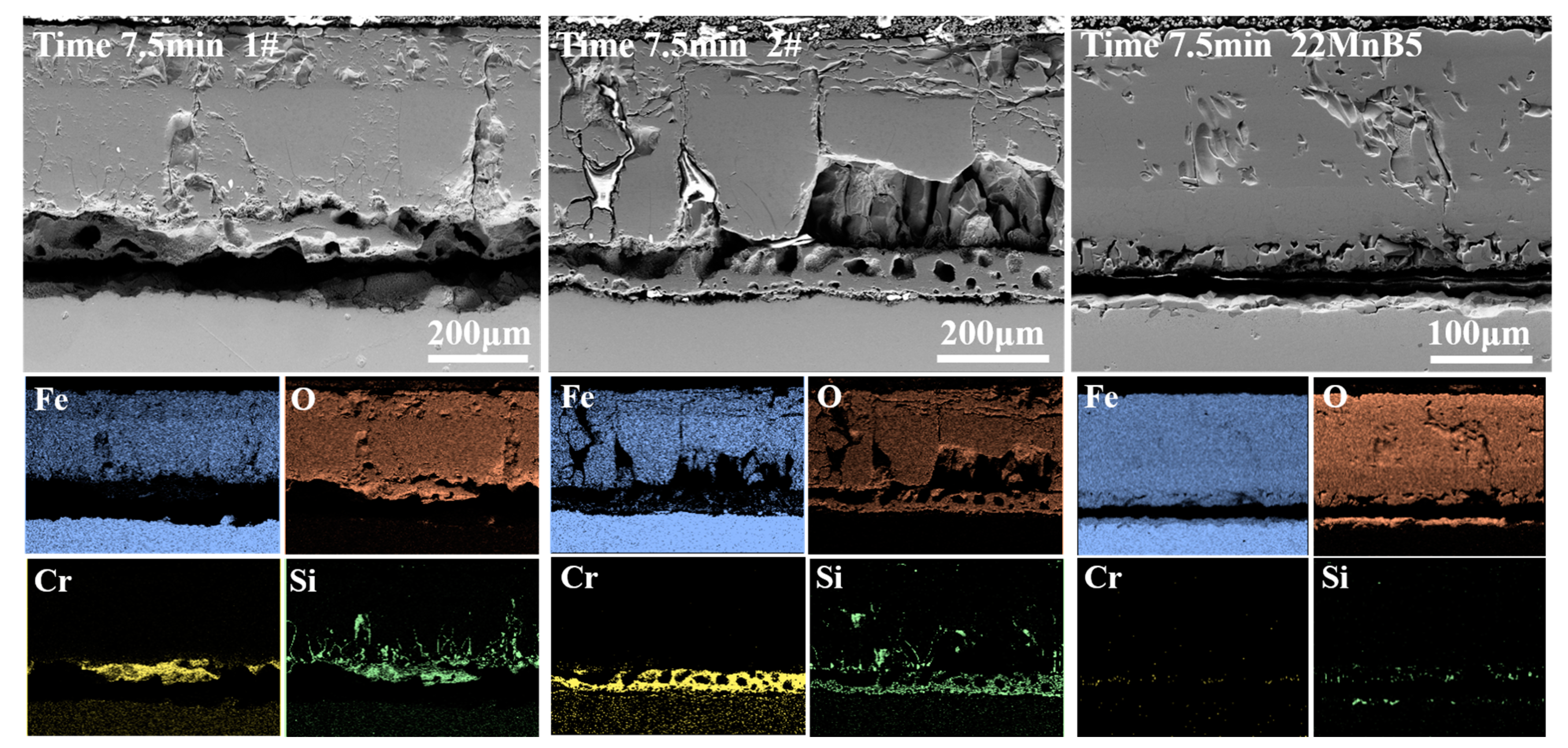

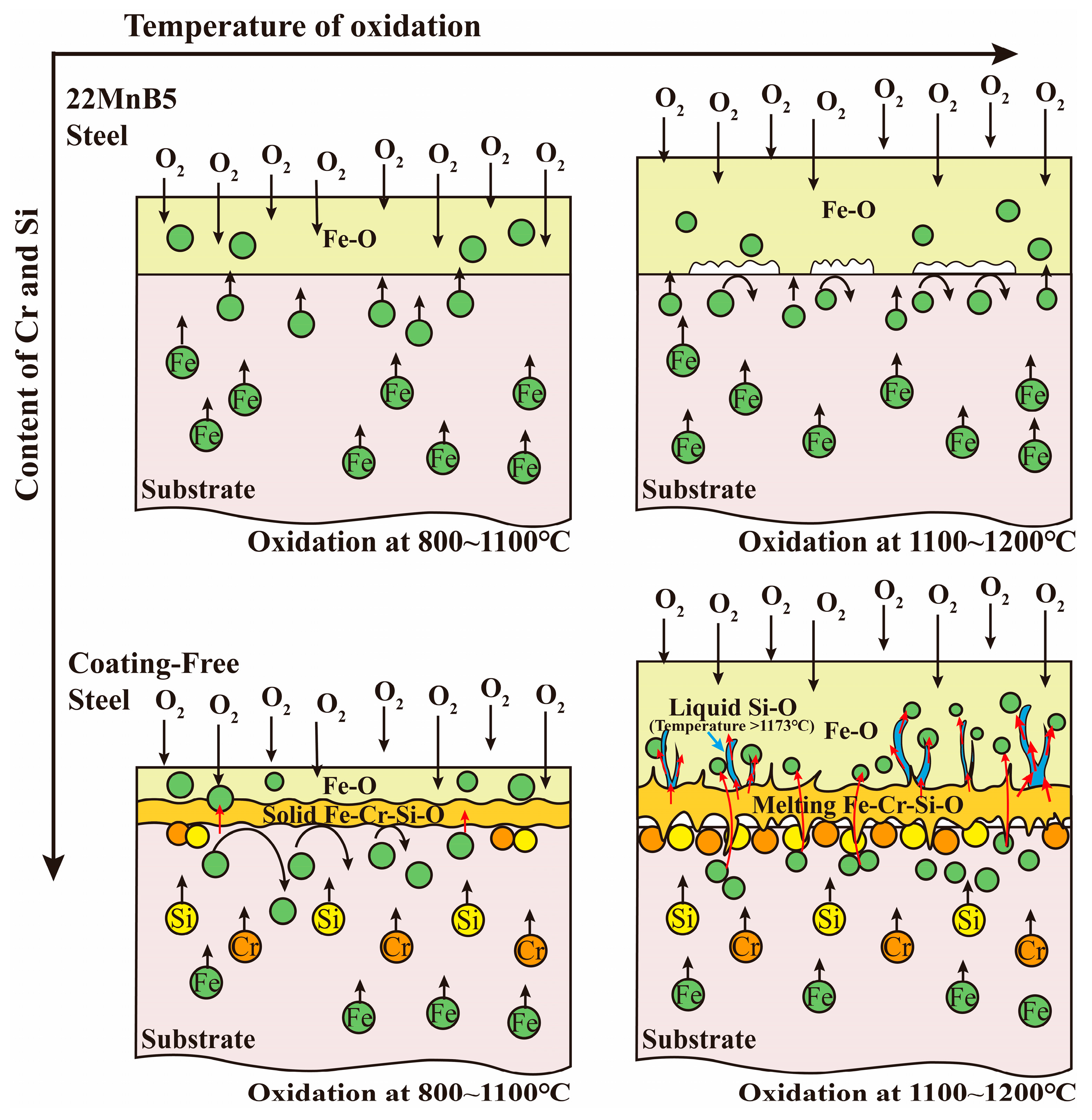
| C | Si | Mn | B | Cr | Ti | Al | V | Fe | |
|---|---|---|---|---|---|---|---|---|---|
| 1# | 0.20 | 1.35 | 1.20 | 0.003 | 2.15 | 0.066 | 0.048 | 0.057 | Bal. |
| 2# | 0.19 | 0.98 | 1.21 | 0.003 | 2.43 | 0.060 | 0.030 | 0.055 | Bal. |
| 22MnB5 | 0.23 | 0.30 | 1.20 | 0.0029 | 0.15 | 0.03 | 0.048 | --- | Bal. |
Disclaimer/Publisher’s Note: The statements, opinions and data contained in all publications are solely those of the individual author(s) and contributor(s) and not of MDPI and/or the editor(s). MDPI and/or the editor(s) disclaim responsibility for any injury to people or property resulting from any ideas, methods, instructions or products referred to in the content. |
© 2023 by the authors. Licensee MDPI, Basel, Switzerland. This article is an open access article distributed under the terms and conditions of the Creative Commons Attribution (CC BY) license (https://creativecommons.org/licenses/by/4.0/).
Share and Cite
Wu, Y.; Zhang, Q.; Zhu, R.; Wang, M.; Jiang, H.; Mi, Z. Studying the Effect of Cr and Si on the High-Temperature Oxidation-Resistance Mechanism of Hot Stamping Steel. Metals 2023, 13, 1670. https://doi.org/10.3390/met13101670
Wu Y, Zhang Q, Zhu R, Wang M, Jiang H, Mi Z. Studying the Effect of Cr and Si on the High-Temperature Oxidation-Resistance Mechanism of Hot Stamping Steel. Metals. 2023; 13(10):1670. https://doi.org/10.3390/met13101670
Chicago/Turabian StyleWu, Yanxin, Qi Zhang, Rong Zhu, Mai Wang, Haitao Jiang, and Zhenli Mi. 2023. "Studying the Effect of Cr and Si on the High-Temperature Oxidation-Resistance Mechanism of Hot Stamping Steel" Metals 13, no. 10: 1670. https://doi.org/10.3390/met13101670





